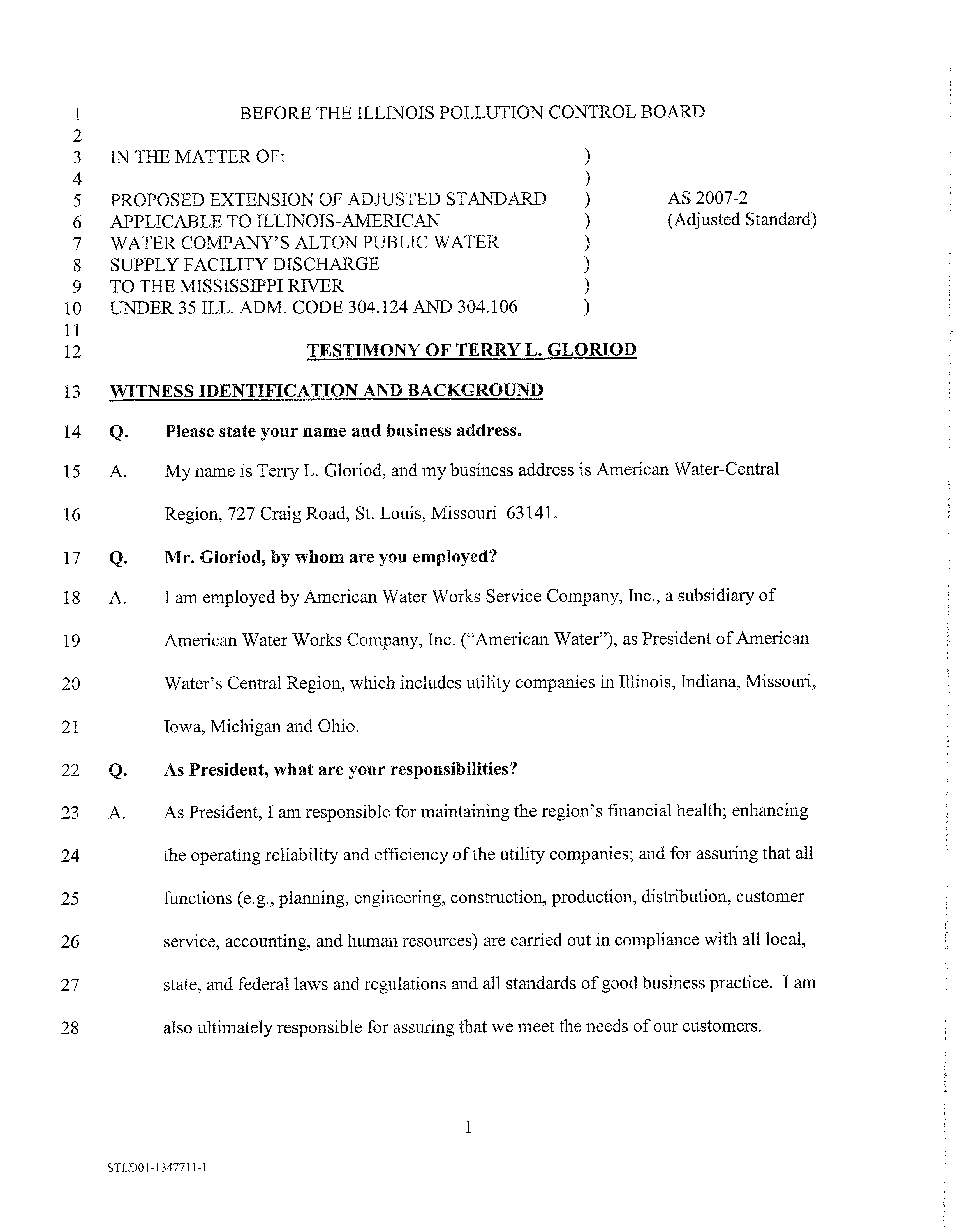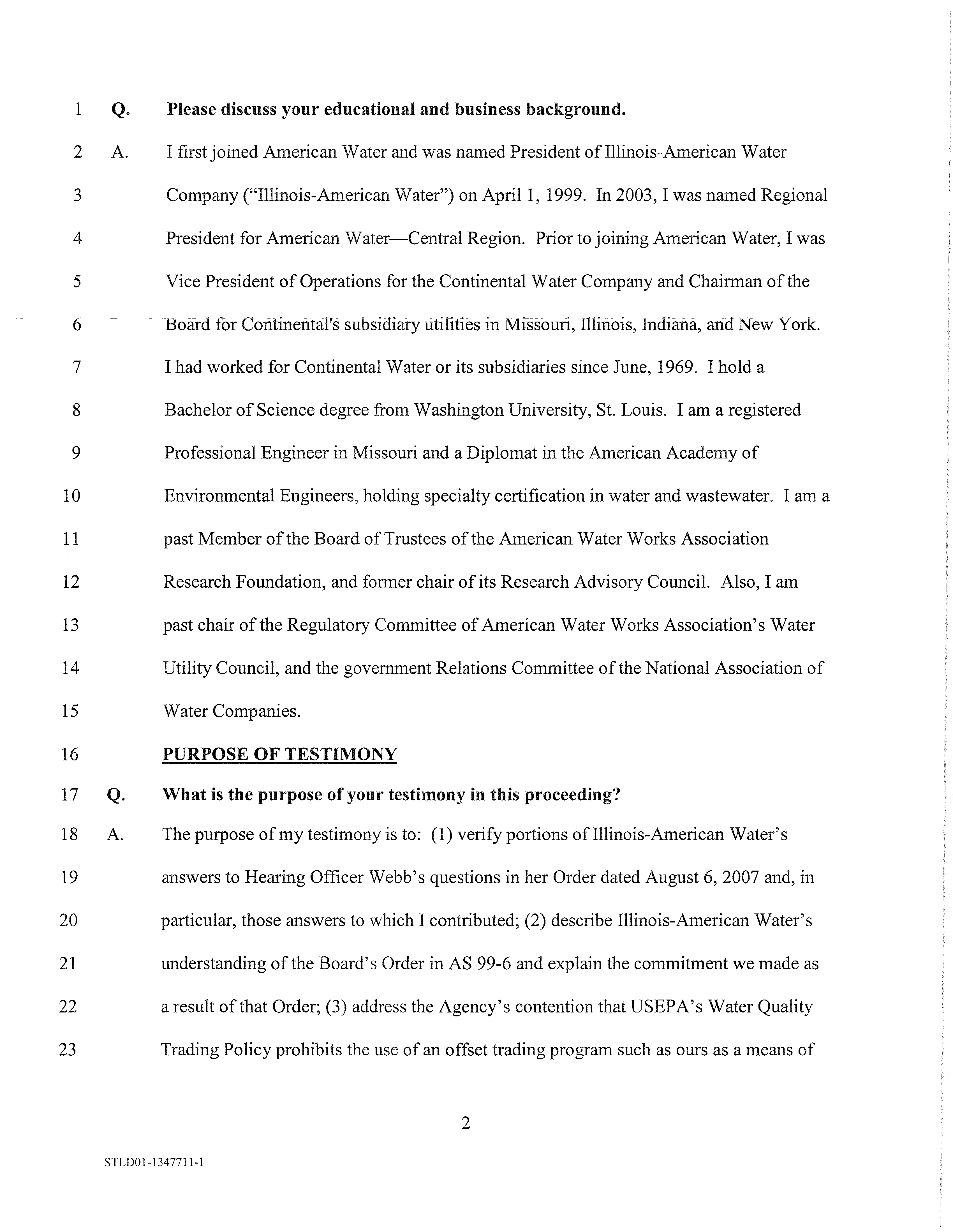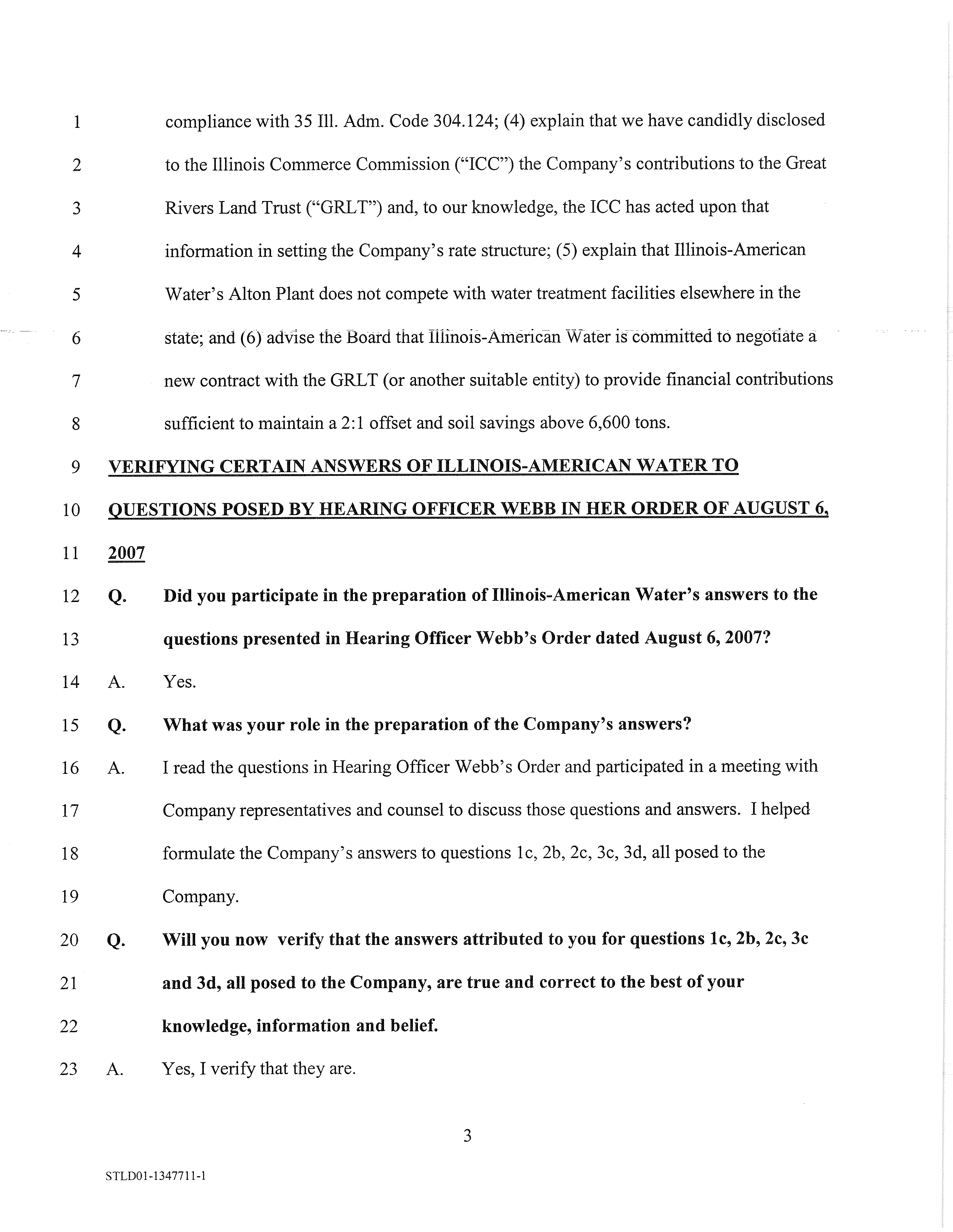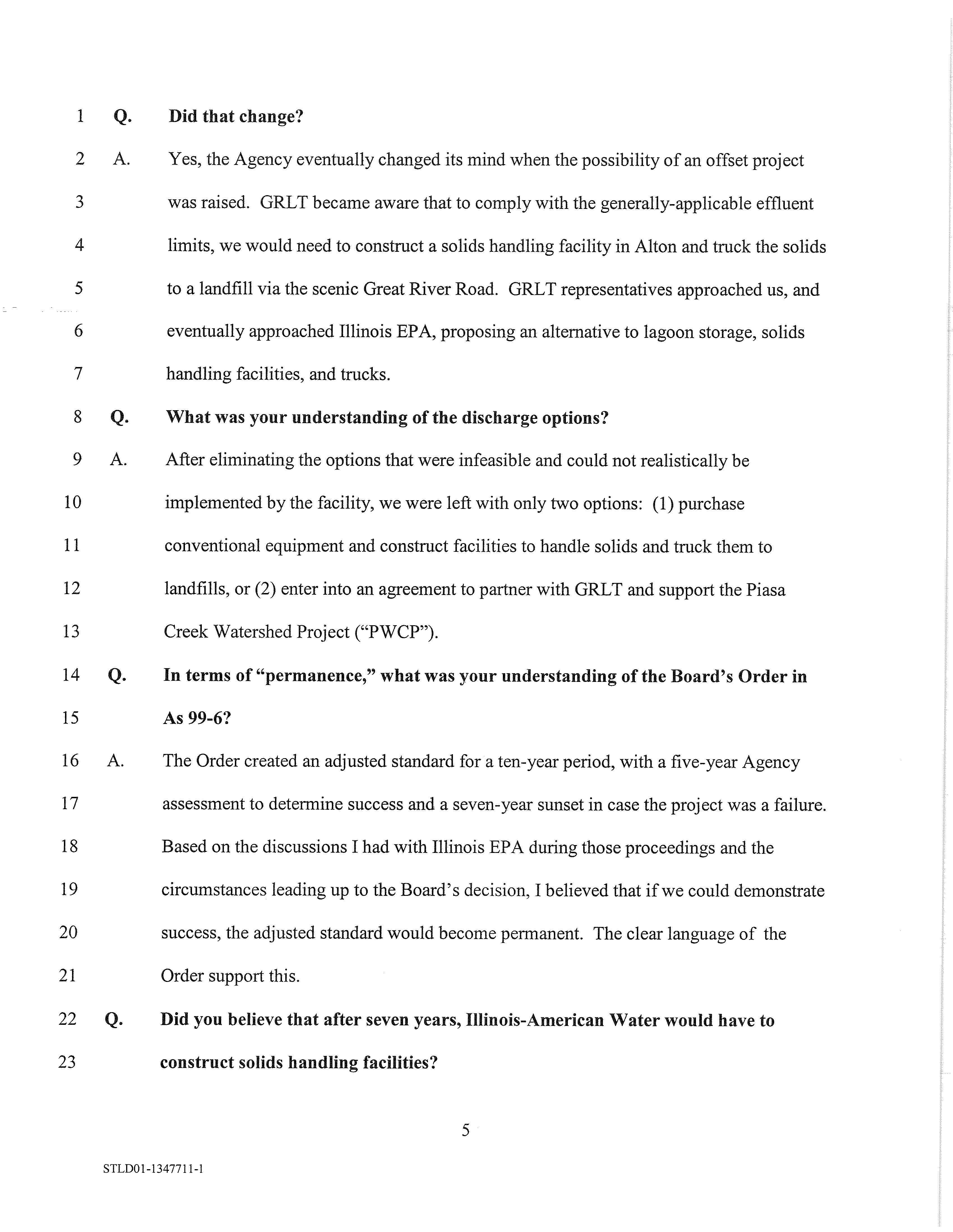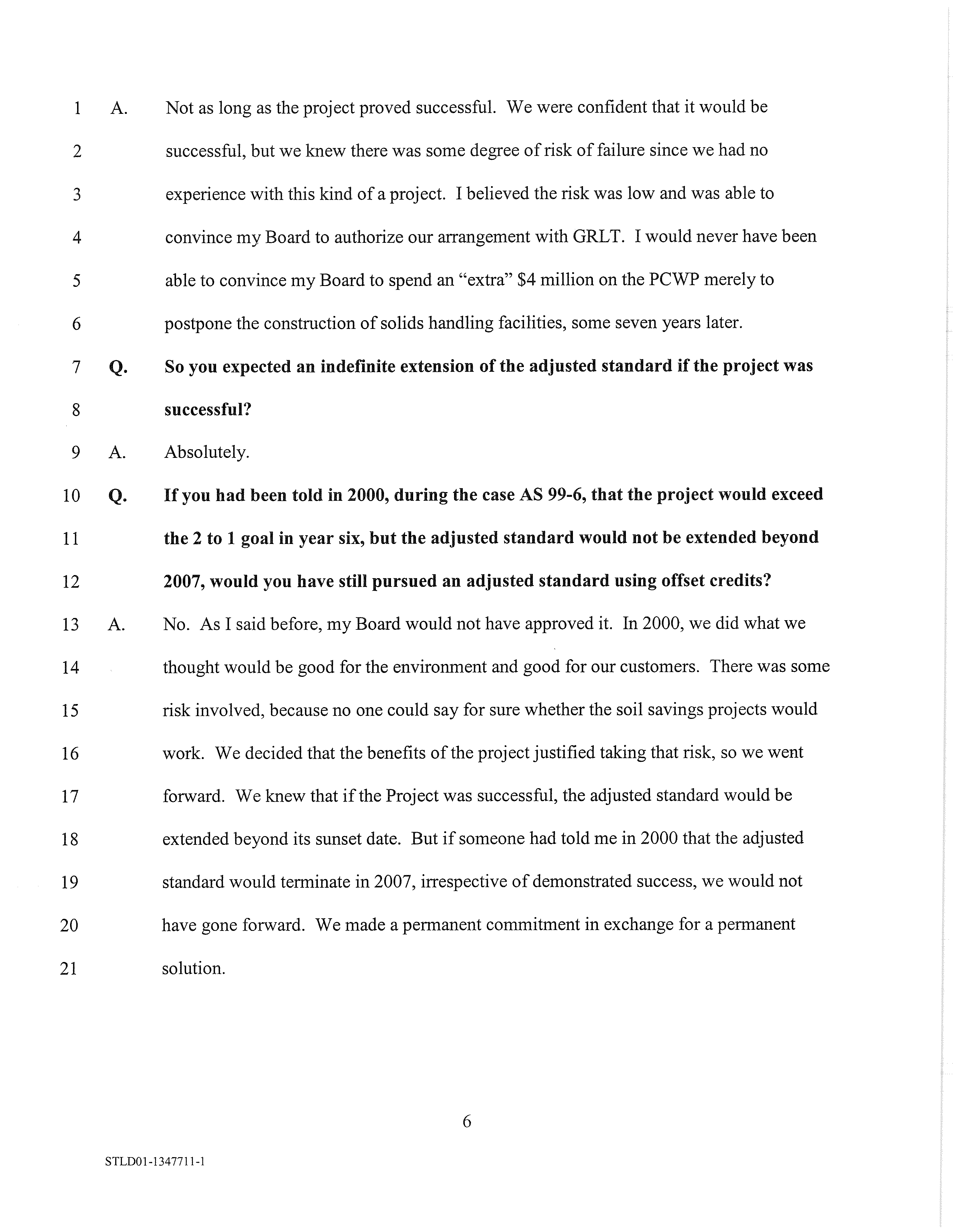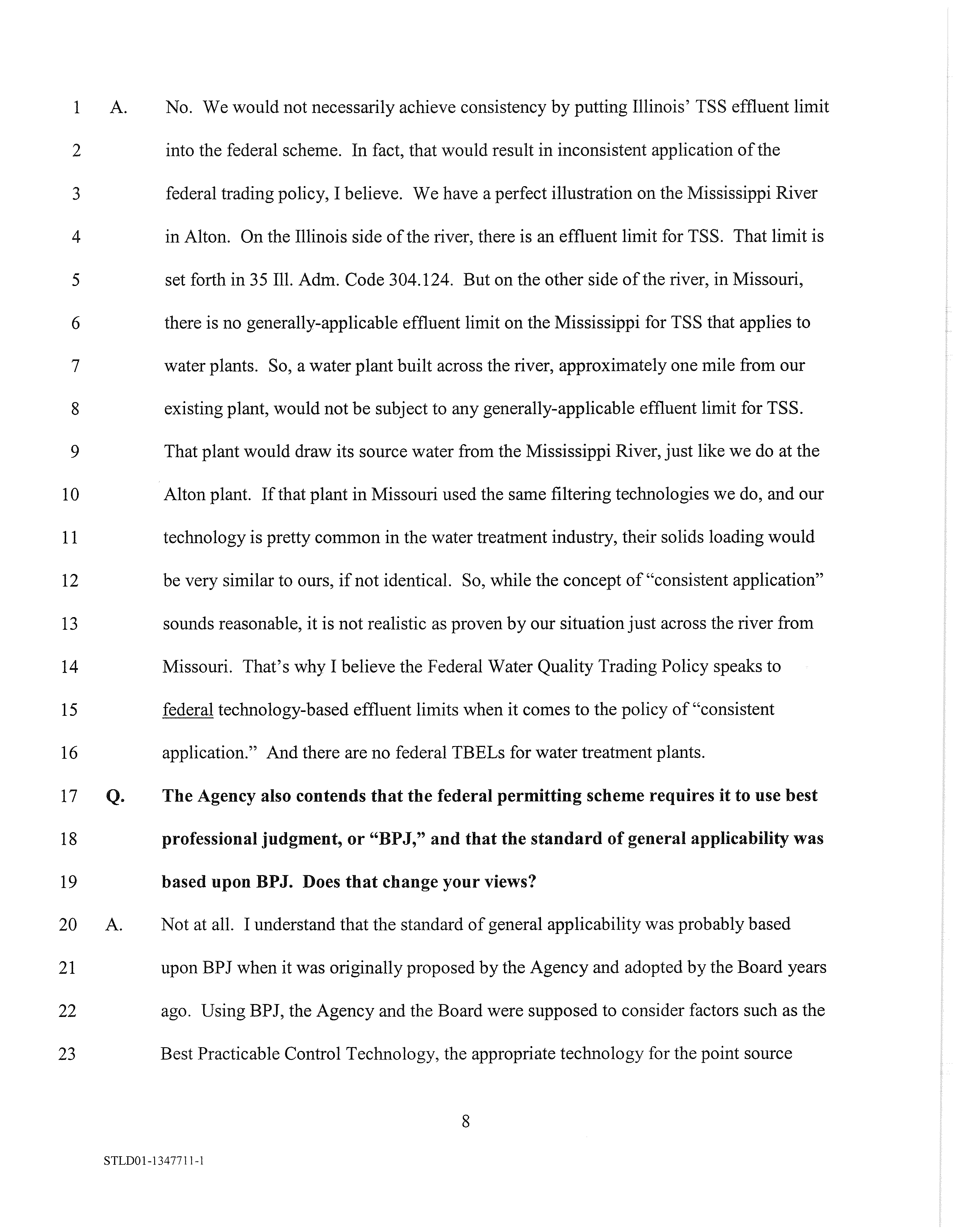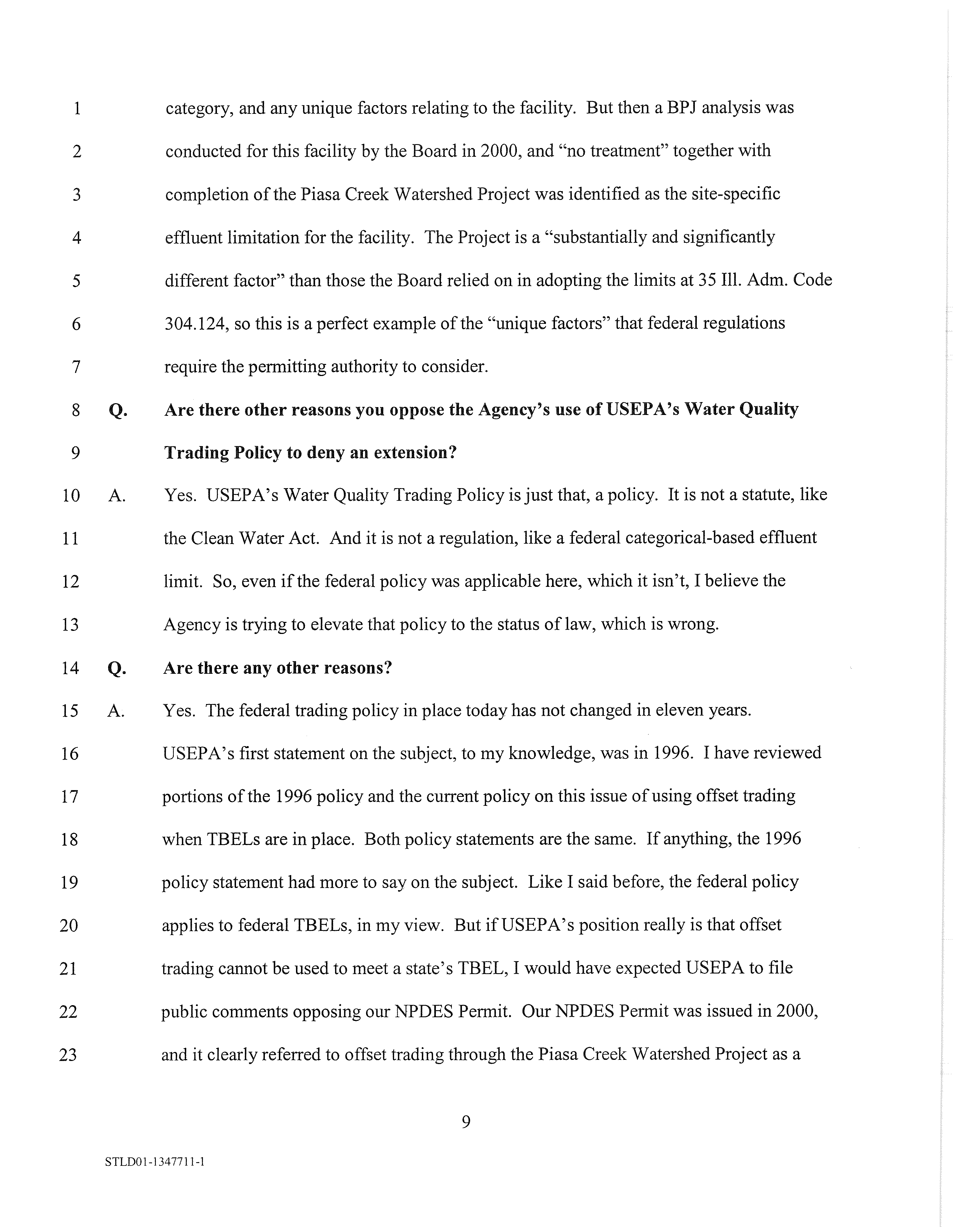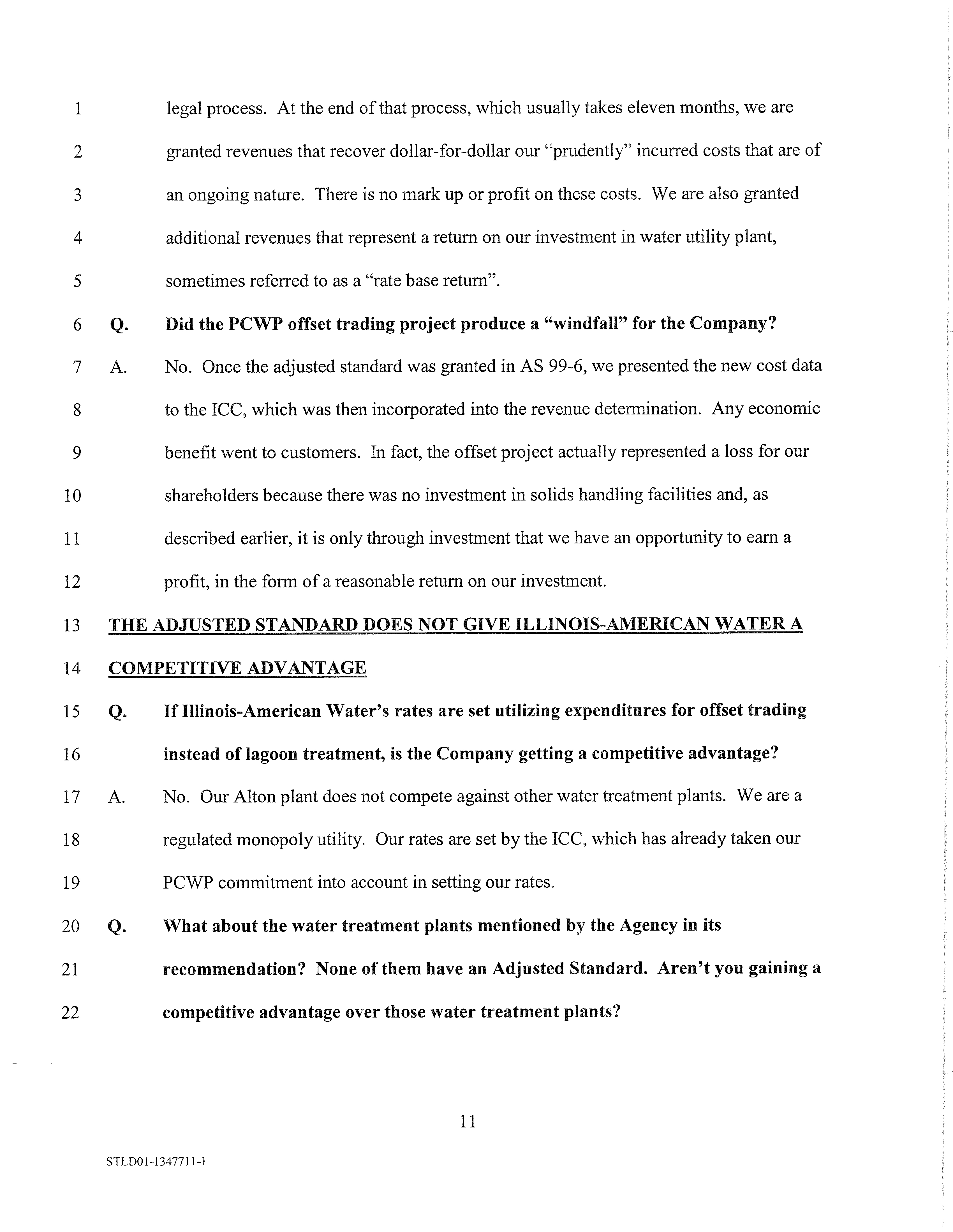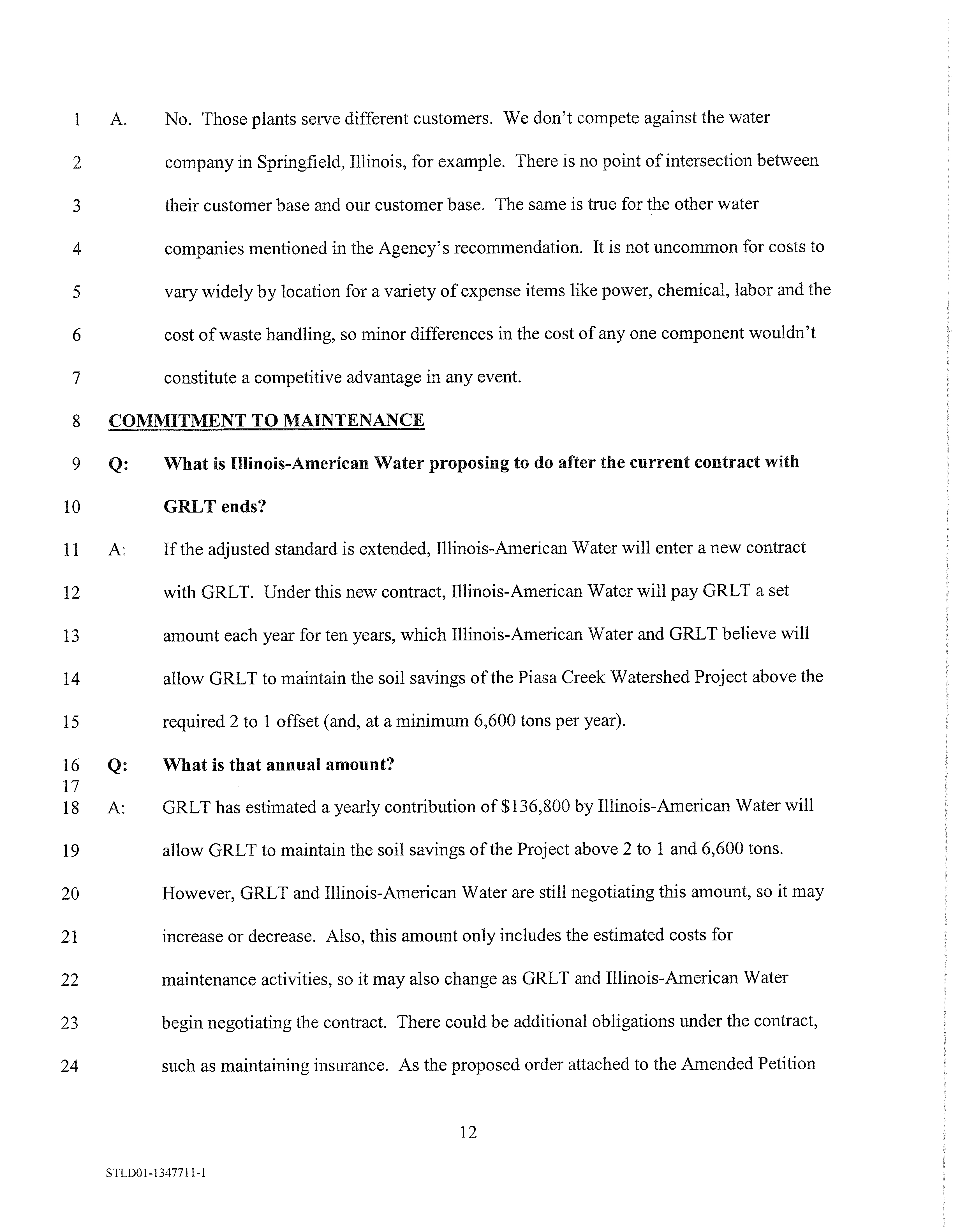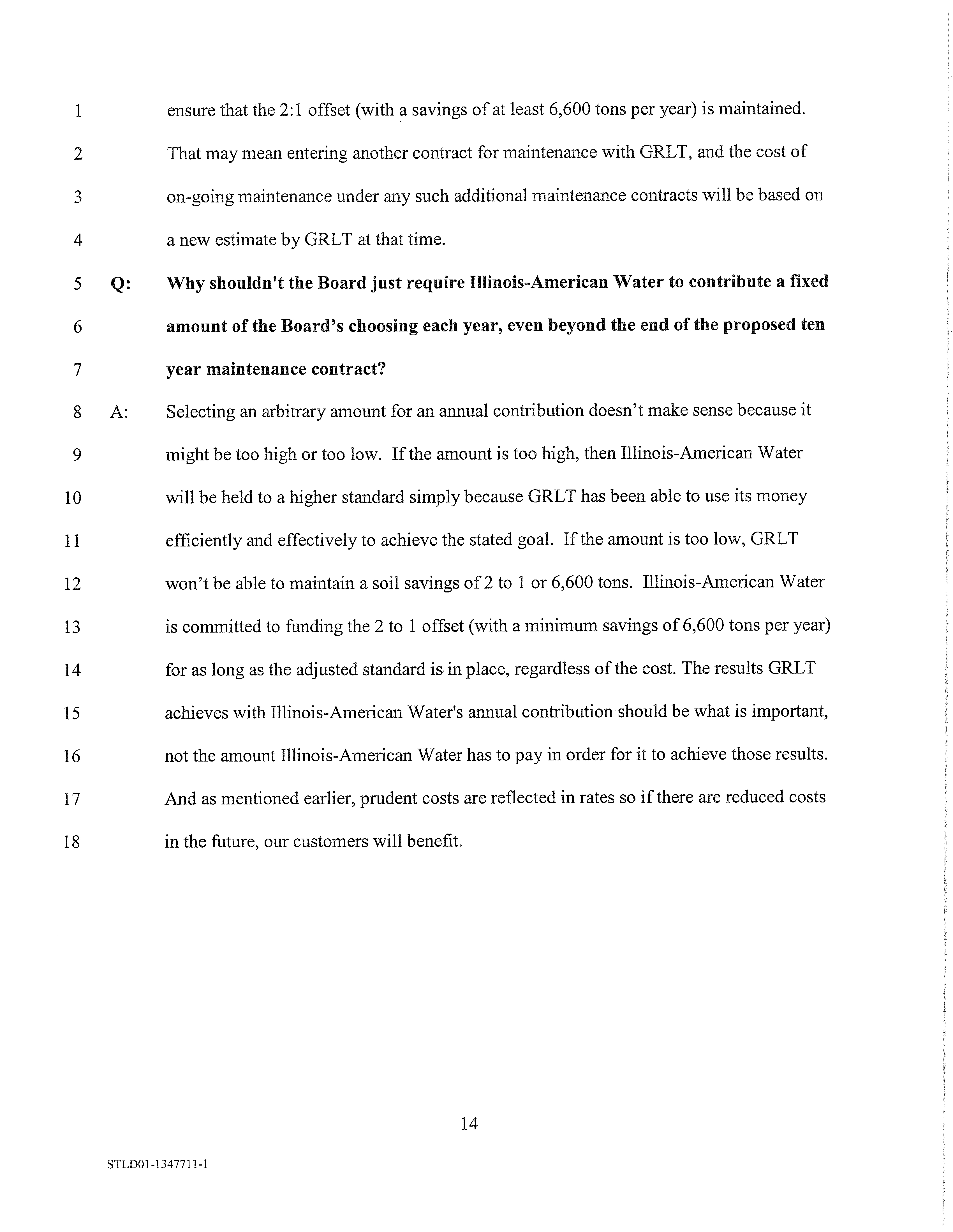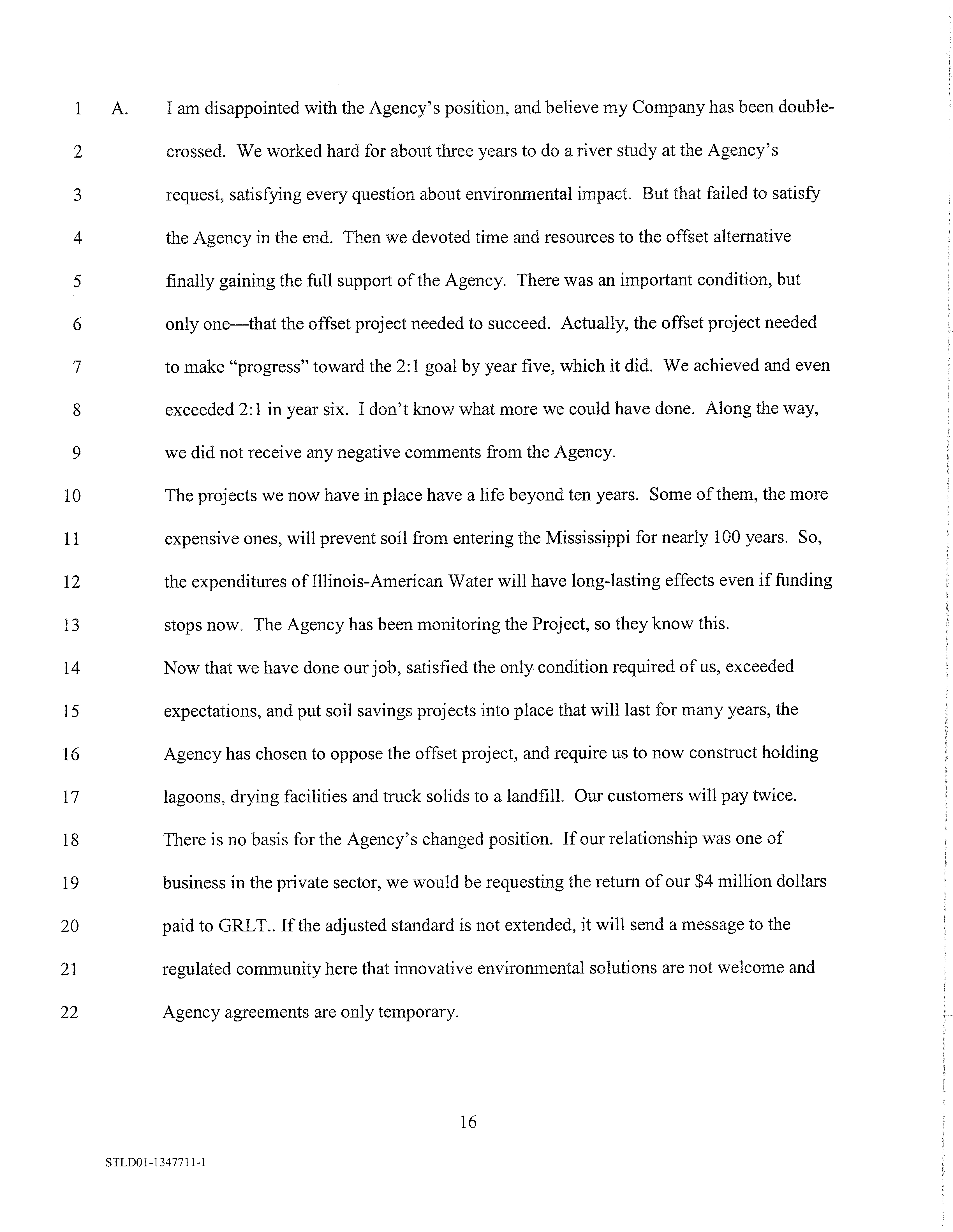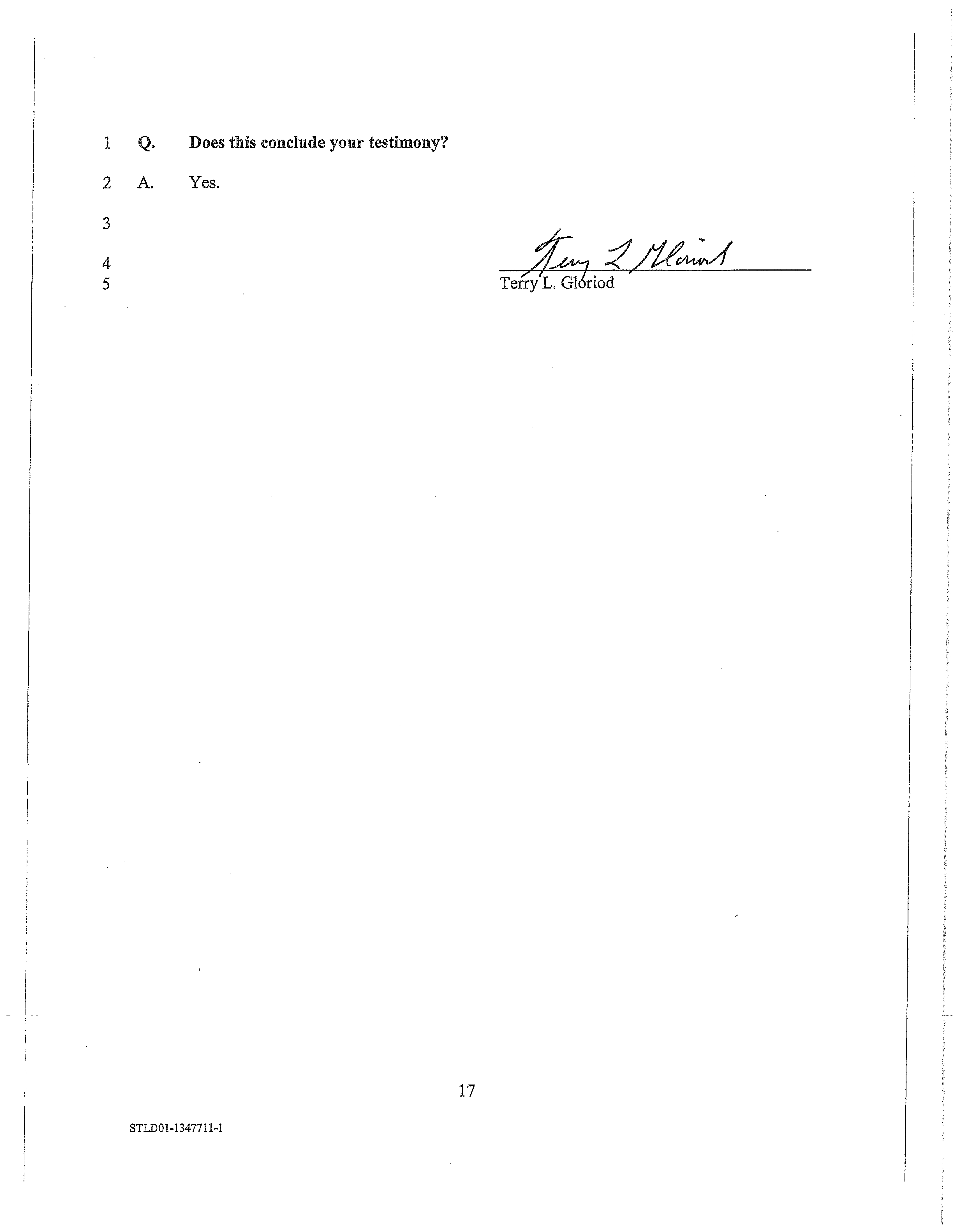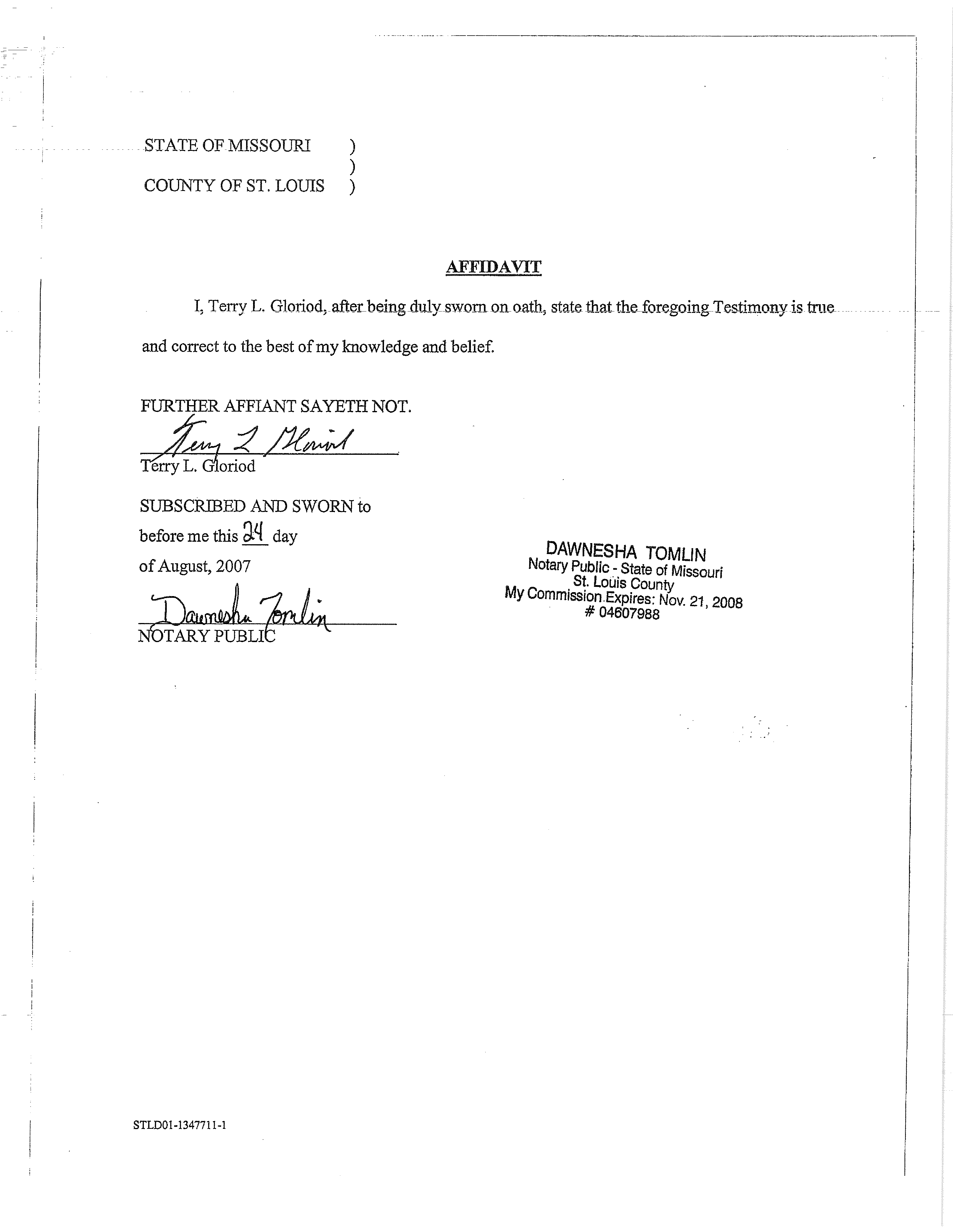BEFORE THE ILLINOIS POLLUTION CONTROL BOARD
TESTIMONY OF TERRY L. GLORIOD
1
2
3
4
5
6
7
8
9
10
11
12
IN THE MATTER OF:
PROPOSED EXTENSION OF ADJUSTED STANDARD
APPLICABLE TO ILLINOIS-AMERICAN
WATER COMPANY'S ALTON PUBLIC WATER
SUPPLY FACILITY DISCHARGE
TO THE MISSISSIPPI
RNER
UNDER 35 ILL. ADM. CODE 304.124 AND 304.106
)
)
)
)
)
)
)
)
AS 2007-2
(Adjusted Standard)
13
WITNESS IDENTIFICATION AND BACKGROUND
14
Q.
15
A.
Please state your name and business address.
My name is Terry L. Gloriod, and my business address is American Water-Central
16
Region, 727 Craig Road, St. Louis, Missouri 63141.
17
Q.
18
A.
19
20
21
22
Q.
23
A.
24
25
26
27
28
Mr. Gloriod, by whom are you employed?
I am employed by American Water Works Service Company, Inc., a subsidiary of
American Water Works Company, Inc. ("American Water"), as President of American
Water's Central Region, which includes utility companies in Illinois, Indiana, Missouri,
Iowa, Michigan and Ohio.
As President, what are your responsibilities?
As President, I am responsible for maintaining the region's financial health; enhancing
the operating reliability and efficiency of the utility companies; and for assuring that all
functions (e.g.,
planning, engineering, construction, production, distribution, customer
service, accounting, and human resources) are carried out in compliance with all local,
state, and federal
laws and regulations and all standards of good business practice. I am
also
ultimately responsible for assuring that we meet the needs of our customers.
1
STLDOl-1347711-1
Electronic Filing, Received, Clerk's Office, August 24, 2007
1
Q.
2
A.
3
4
5
6
7
8
9
10
11
12
13
14
15
16
17
Q.
18
A.
19
20
21
22
23
Please discuss your educational and business background.
I first joined American Water and was named President of Illinois-American Water
Company ("Illinois-American Water") on April 1, 1999. In 2003, I was named Regional
President for American
Water-Central Region. Prior to joining American Water, I was
Vice President
of Operations for the Continental Water Company and Chairman of the
Board for Continental'ssubsidiary utilities in Missouri, Illinois, Indiana, and
New York.
I had worked for Continental Water or its subsidiaries since June, 1969. I hold a
Bachelor
of Science degree from Washington University, St. Louis. I am a registered
Professional Engineer in Missouri and a Diplomat in the American Academy
of
Environmental Engineers, holding specialty certification in water and wastewater. I am a
past Member
of the Board of Trustees of the American Water Works Association
Research Foundation, and former chair
of its Research Advisory Council. Also, I am
past chair
of the Regulatory Committee of American Water Works Association's Water
Utility Council, and the government Relations Committee
of the National Association of
Water Companies.
PURPOSE OF TESTIMONY
What is the purpose of your testimony in this proceeding?
The purpose of my testimony is to: (1) verify portions of Illinois-American Water's
answers to Hearing Officer Webb'squestions in her Order dated August 6, 2007 and, in
particular, those answers to which I contributed; (2) describe Illinois-American Water's
understanding
of the Board'sOrder in AS 99-6 and explain the commitment we made as
a result
of that Order; (3) address the Agency'scontention that USEPA's Water Quality
Trading Policy prohibits the use
of an offset trading program such as ours as a means of
2
STLDO1-1347711-1
Electronic Filing, Received, Clerk's Office, August 24, 2007
1
compliance with 35 Ill. Adm. Code 304.124; (4) explain that we have candidly disclosed
2
to the Illinois Commerce Commission ("ICC") the Company's contributions to the Great
3
Rivers Land Trust ("GRLT") and, to our knowledge, the ICC has acted upon that
4
information in setting the Company'srate structure; (5) explain that Illinois-American
5
Water'sAlton Plant does not compete with water treatment facilities elsewhere in the
6
state; and (6) advise the Board that Illinois-American Water is committed to negotiate a
7
new contract with the GRLT (or another suitable entity) to provide financial contributions
8
sufficient to maintain a 2:1 offset and soil savings above 6,600 tons.
9
VERIFYING
CERTAIN ANSWERS OF ILLINOIS-AMERICAN WATER TO
10
QUESTIONS POSED BY HEARING OFFICER WEBB IN HER ORDER OF AUGUST 6,
11
2007
12
Q.
13
14
A.
15
Q.
16
A.
17
18
19
20
Q.
21
22
23
A.
Did you
participate in the preparation of Illinois-American Water's answers to the
questions presented in Hearing Officer
Webb's Order dated August 6, 2007?
Yes.
What was your role in the preparation of the Company'sanswers?
I read the questions in Hearing Officer Webb's Order and participated in a meeting with
Company representatives and counsel to discuss those questions and answers. I helped
formulate the Company'sanswers to questions lc, 2b, 2c, 3c, 3d, all posed to the
Company.
Will you now verify
that the answers attributed to you for questions Ic, 2b, 2c, 3c
and 3d, all posed to the Company, are true and correct to the best of your
knowledge, information and belief.
Yes, I verify that they are.
3
STLDOl-13477 11-1
Electronic Filing, Received, Clerk's Office, August 24, 2007
1
Q.
2
3
A.
Did you provide
input on behalf of Illinois-American Water to any other answers in
the Company's response to Hearing Officer Webb's questions?
Yes. I authorized our legal counsel to provide the Company'sresponse to question 4,
4
posed to the Company, the "Rulemaking Update," and I endorse that response now.
5
ILLINOIS-AMERICAN WATER'S UNDERSTANDING OF THE BOARD'SORDER IN
6
AS 99-6
7
Q.
8
A.
9
10
Q.
11
12
A.
13
14
15
16
17
18
19
20
21
22
Were you involved in the original adjusted standard proceeding, Case AS 99-6?
Yes. I was involved in the decision to seek an adjusted standard for our new facility in
Alton.
Describe Illinois-American Water's interaction with the Agency in connection with
the adjusted standard case in 1999.
Our Alton plant at the time had been direct discharging for about 100 years. The NPDES
program came into effect in the 1970s, which prompted us to obtain a site-specific
standard to continue to direct discharge to the Mississippi. We felt like the new plant
would be the same in all respects.
It would still draw source water from the Mississippi
and discharge to the Mississippi in the same location. All we were doing, really, was
building a new plant at a higher elevation, serving the same customer base too. So, we
sought the
Agency'sposition and their input on continuing with direct discharge.
Agency representatives requested river studies. We did that, using an outside engineering
firm, and those studies were exhaustive. The Agency asked for even more studies, so we
did those too. At the conclusion
of all those studies, the Agency chose not to support
direct discharge, instead favoring solids limits.
4
STLDOl-1347711-1
Electronic Filing, Received, Clerk's Office, August 24, 2007
1
Q.
2
A.
3
4
5
6
7
8
Q.
9
A.
10
11
12
13
14
Q.
15
16
A.
17
18
19
20
21
22
Q.
23
Did that change?
Yes, the Agency eventually changed its mind when the possibility of an offset project
was raised. GRLT became aware that to comply with the generally-applicable effluent
limits, we would need to construct a solids handling facility in Alton and truck the solids
to a landfill via the scenic Great River Road. GRLT representatives approached us, and
eventually approached Illinois EPA, proposing an alternative to lagoon storage, solids
handling facilities, and trucks.
What was your understanding of the discharge options?
After eliminating the options that were infeasible and could not realistically be
implemented by the facility, we were left with only two options: (1) purchase
conventional equipment and construct facilities to handle solids and truck them to
landfills, or (2) enter into an agreement to partner with GRLT and support the Piasa
Creek Watershed Project ("PWCP").
In terms of "permanence," what was your understanding of the Board's Order in
As 99-6?
The Order created an adjusted standard for a ten-year period, with a five-year Agency
assessment to determine success and a seven-year sunset in case the project was a failure.
Based on the discussions I had with Illinois EPA during those proceedings and the
circumstances leading up to the Board'sdecision, I believed that if we could demonstrate
success, the adjusted standard would become permanent. The clear language
of the
Order support this.
Did you believe that after seven years, Illinois-American Water would have to
construct solids handling facilities?
5
STLDOl-1347711-1
Electronic Filing, Received, Clerk's Office, August 24, 2007
1
A.
2
3
4
5
6
7
Q.
8
9
A.
10
Q.
11
12
13
A.
14
15
16
17
18
19
20
21
Not as long as the project proved successful. We were confident that it would be
successful, but we knew there was some degree
of risk of failure since we had no
experience with this kind
of a project. I believed the risk was low and was able to
convince
my Board to authorize our arrangement with GRLT. I would never have been
able to convince my Board to spend an "extra" $4 million on the PCWP merely to
postpone the construction
of solids handling facilities, some seven years later.
So you expected an indefinite extension of the adjusted standard if the project was
successful?
Absolutely.
If you had been told in 2000, during the case AS 99-6, that the project would exceed
the 2 to 1 goal in
year six, but the adjusted standard would not be extended beyond
2007, would you have still
pursued an adjusted standard using offset credits?
No. As I said before, my Board would not have approved it. In 2000, we did what we
thought would be good for the environment and good for our customers. There was some
risk involved, because no one could say for sure whether the soil savings projects would
work. We decided that the benefits
of the project justified taking that risk, so we went
forward. We knew that
if the Project was successful, the adjusted standard would be
extended beyond its sunset date. But
if someone had told me in 2000 that the adjusted
standard would terminate in 2007, irrespective
of demonstrated success, we would not
have gone forward. We made a permanent commitment in exchange for a permanent
solution.
6
STLDOl-134771 1-1
Electronic Filing, Received, Clerk's Office, August 24, 2007
2
Q.
3
4
5
6
7
A.
8
Q.
9
A.
10
11
12
13
14
Q.
15
16
17
A.
18
19
20
21
Q.
22
1
USEPA'S WATER QUALITY TRADING POLICY
As you know, Mr. Gloried, the Agency has contended in its Recommendation that
USEPA's Water Quality Trading Policy should be taken into account. Specifically,
the Agency contends that the Water Quality Trading Policy prohibits the use of
offset credits in order to comply with a technology-based effluent limit. Do you
agree
with the Agency's interpretation of USEPA's policy?
No.
Why not?
The federal trading policy'sprohibition applies to federal technology-based effluent
limits. USEPA does not have technology-based effluent limits for water treatment plants.
USEPA has many categorical effluent limits applying to many industries. But there are
no federal technology-based effluent limits for water treatment plants. Therefore, the
federal trading policy is not triggered.
The Agency has taken the position that USEPA's policy should prohibit trading to
comply
with Illinois' standard for TSS, which is found at 35 Ill. Adm. Code 304.124,
because
that standard is a technology-based effluent limit. Do you agree?
No. The state standard is not a categorical standard for the drinking water industry.
It
is
a state standard
of general applicability and not a categorical standard under the Clean
Water Act. So, the trading policy is not applicable and is not a reason to terminate an
adjusted standard.
The Agency has also taken the position that USEPA'spolicy should prohibit trading
to comply with Illinois' standard for TSS for the sake of consistency. Do you agree?
7
STLDOl-134771 I-I
Electronic Filing, Received, Clerk's Office, August 24, 2007
1
A.
2
3
4
5
6
7
8
9
10
11
12
13
14
15
16
17
Q.
18
19
20
A.
21
22
23
No. We would not necessarily achieve consistency by putting Illinois' TSS effluent limit
into the federal scheme. In fact, that would result in inconsistent application
of the
federal trading policy, I believe. We have a perfect illustration on the Mississippi River
in Alton. On the Illinois side
of the river, there is an effluent limit for TSS. That limit is
set forth in 35 Ill. Adm. Code 304.124. But on the other side
of the river, in Missouri,
there is no generally-applicable effluent limit on the Mississippi for TSS that applies to
water plants. So, a water plant built across the river, approximately one mile from
our
existing plant, would not be subject to any generally-applicable effluent limit for TSS.
That plant would draw its source water from the Mississippi River,
just like we do at the
Alton plant.
If that plant in Missouri used the same filtering technologies we do, and our
technology is pretty common in the water treatment industry, their solids loading would
be very similar to ours,
if not identical. So, while the concept of "consistent application"
sounds reasonable, it is not realistic as proven
by our situation just across the river from
Missouri. That'swhy I believe the Federal Water Quality Trading Policy speaks to
federal technology-based effluent limits when it comes to the policy
of "consistent
application." And there are no federal TBELs for water treatment plants.
The Agency also contends that the federal permitting scheme requires it to use best
professional judgment,
or "BPJ," and that the standard of general applicability was
based upon BPJ. Does
that change your views?
Not at all. I understand that the standard of general applicability was probably based
upon BPJ when it was originally proposed
by the Agency and adopted by the Board years
ago. Using BPJ, the Agency and the Board were supposed to consider factors such as the
Best Practicable Control Technology, the appropriate technology for the point source
8
STLDOl-134771 1-1
Electronic Filing, Received, Clerk's Office, August 24, 2007
1
2
3
4
5
6
7
8
Q.
9
10
A.
11
12
13
14
Q.
15
A.
16
17
18
19
20
21
22
23
category, and any unique factors relating to the facility. But then a BPJ analysis was
conducted for this facility by the Board in 2000, and "no treatment" together with
completion
of the Piasa Creek Watershed Project was identified as the site-specific
effluent limitation for the facility. The Project is a "substantially and significantly
different factor" than those the Board relied on in adopting the limits at 35 Ill. Adm. Code
304.124, so this is a perfect example
of the "unique factors" that federal regulations
require the permitting authority to consider.
Are there other reasons you oppose the Agency's use of USEPA's Water Quality
Trading Policy to deny an extension?
Yes. USEPA'sWater Quality Trading Policy is just that, a policy. It is not a statute, like
the Clean Water Act. And it is not a regulation, like a federal categorical-based effluent
limit. So, even
if the federal policy was applicable here, which it isn't, I believe the
Agency is trying to elevate that policy to the status
of law, which is wrong.
Are there any other reasons?
Yes. The federal trading policy in place today has not changed in eleven years.
USEPA'sfirst statement on the subject, to my knowledge, was in 1996. I have reviewed
portions
of the 1996 policy and the current policy on this issue of using offset trading
when TBELs are in place. Both policy statements are the same.
If anything, the 1996
policy statement had more to say on the subject. Like I said before, the federal policy
applies to federal TBELs, in my view. But
ifUSEPA's position really is that offset
trading cannot be used to meet a state'sTBEL, I would have expected USEPA to file
public comments opposing our NPDES Permit. Our NPDES Permit was issued in 2000,
and it clearly referred to offset trading through the Piasa Creek Watershed Project as a
9
STLDOl-1347711-1
Electronic Filing, Received, Clerk's Office, August 24, 2007
1
2
3
4
5
6
Q.
7
A.
8
9
10
11
12
13
Q.
14
15
16
A.
17
means of compliance. But USEPA did not oppose that permit. Obviously, Illinois EPA
did not oppose the permit either, because they issued it. Ifthere is an inconsistency
today, that
same inconsistency existed in 1999, when the Agency supported and the
Board agreed to an adjusted standard.
The Agency has changed its position, but it is not
accurate to say that USEPA has too.
Are there any other reasons you have not addressed?
I can think of one more, and it is significant. For many years now, USEPA has enforced
an anti-backsliding policy. I believe backsliding
would be inevitable ifwe stop the
Project.
It is puzzling to me that the Agency would not consider anti-backsliding in
connection
with our offset trading accomplishments. I am also troubled by the prospect
that the Agency might have in mind the scenario of lagoon treatment and maintenance of
the soil savings projects in order to comply with the anti-backsliding prohibition.
Has the Agency ever informed you, or to your knowledge anyone else at Illlnots-
American
Water that USEPA's Water Quality Trading Policy should be applied in
a way
that would deny an extension of the Adjusted Standard?
Not until the Agency filed its Recommendation. That was the first time we heard that the
Agency would be taking this position.
18
DISCLOSURE OF PCWP CONTRIBUTIONS TO THE ILLINOIS COMMERCE
19
COMMISSION
20
Q.
21
22
A.
23
How does the rate setting process work before the Illinois Commerce Commission
("ICC")?
Illinois-American Water presents evidence to the ICC regarding operating costs and
investments.
The ICC's staff and any interveners audit that evidence through a structured
10
STLDOl-1347711-1
Electronic Filing, Received, Clerk's Office, August 24, 2007
1
2
3
4
5
6
Q.
7
A.
8
9
10
legal process. At the end
of that process, which usually takes eleven months, we are
granted revenues that recover dollar-for-dollar
our "prudently" incurred costs that are of
an ongoing nature. There is no mark up or profit on these costs. Weare also granted
additional revenues that represent a return on our investment in water utility plant,
sometimes referred to as a "rate base return".
Did the PCWP offset trading project produce a "windfall" for the Company?
No. Once the adjusted standard was granted in AS 99-6, we presented the new cost data
to the ICC, which was then incorporated into the revenue determination.
Any economic
benefit
went to customers.
In
fact, the offset project actually represented a loss for our
shareholders because there was no investment in solids handling facilities and, as
11
described earlier, it is only through investment that we have an opportunity to earn a
12
profit, in the form
of a reasonable return on our investment.
13
THE ADJUSTED STANDARD DOES NOT GIVE ILLINOIS-AMERICAN WATER A
14
COMPETITIVE ADVANTAGE
15
Q.
16
17
A.
18
19
20
Q.
21
22
If Illinois-American Water's rates are set utilizing expenditures for offset trading
instead of lagoon treatment, is the Company getting a competitive advantage?
No. Our Alton plant does not compete against other water treatment plants. We are a
regulated monopoly utility. Our rates are set by the ICC, which has already taken our
PCWP commitment into account in setting our rates.
What about the water treatment plants mentioned by the Agency in its
recommendation? None
of them have an Adjusted Standard. Aren'tyou gaining a
competitive
advantage over those water treatment plants?
11
STLDOl-1347711-1
Electronic Filing, Received, Clerk's Office, August 24, 2007
1
A.
No. Those plants serve different customers. We don'tcompete against the water
2
company in Springfield, Illinois, for example. There is no point
of intersection between
3
their customer base and our customer base. The same is true for the other water
4
companies mentioned in the Agency'srecommendation.
It
is not uncommon for costs to
5
vary widely
by location for a variety of expense items like power, chemical, labor and the
6
cost
ofwaste handling, so minor differences in the cost of anyone component wouldn't
7
constitute a competitive advantage in any
event
8
COMMITMENT TO MAINTENANCE
9
Q:
10
11
A:
12
13
14
15
16
Q:
17
18
A:
19
20
21
22
23
24
What is Illinois-American Water proposing to do after the current contract with
GRLTends?
If the adjusted standard is extended, Illinois-American Water will enter a new contract
with GRLT. Under this new contract, Illinois-American Water will
pay GRLT a set
amount each year for ten years, which Illinois-American Water and GRLT believe will
allow GRLT to maintain the soil savings
of the Piasa Creek Watershed Project above the
required 2 to 1 offset (and, at a minimum 6,600 tons per year).
What is that annual amount?
GRLT has estimated a yearly contribution of$136,800 by Illinois-American Water win
allow GRLT to maintain the soil savings of the Project above 2 to 1 and 6,600 tons.
However, GRLT and Illinois-American Water are still negotiating this amount, so it may
increase or decrease. Also, this amount only includes the estimated costs for
maintenance activities, so it
may also change as GRLT and Illinois-American Water
begin negotiating the contract There could be additional obligations under the contract,
such as maintaining insurance. As the proposed order attached to the Amended Petition
12
STLDOl-1347711-1
Electronic Filing, Received, Clerk's Office, August 24, 2007
1
2
3
4
Q:
5
6
A:
7
8
9
10
11
12
Q:
13
A:
14
15
16
17
18
19
20
21
22
23
requires, Illinois-American Water will enter into a contract for maintenance no later than
sixty days after the Board'sadoption
of the adjusted standard, and will provide a copy of
the agreement to the Agency within 10 days after entering the contract.
How will contributing $136,800 each year allow GRLT to maintain the soil savings
of the Project above 2 to 1
and 6,600 tons?
GRLT will use the money to complete stewardship activities for the existing sediment
reduction projects. I understand that these activities will include maintenance
of ground
cover, tree plantings, grade control structures, basins, stream bank stabilization, mowing,
invasive species control, controlled bums, seed collection, tile and drain structure
maintenance, and any other activities necessary to support the intended purpose
of the
individual projects.
What happens after the end of the 10 year maintenance period?
GRLT's proposal for maintenance includes a $25,000 "set aside" each year, which will be
put into an endowment fund. GRL
T's hope is that this endowment fund will be large
enough, after the end
of the 10 year maintenance contract, to allow GRLT to sustain the
projects without additional contributions by Illinois-American Water. But
it'shard to
predict what the soil savings will be in 10 years. A lot can change over that period
of
time. For instance, if Illinois experiences flooding like it did in the early 1990s, some of
the existing soil sediment savings projects may wash out and need to be replaced. Also, if
the concentration of sediments in the River increases, the concentration of sediments in
the facility's influent will also increase and GRLT may need to complete new sediment
reductions projects to achieve the 2 to 1 offset.
If continued projects and maintenance are
necessary beyond the 10-year maintenance period, then the Company will take action to
13
STLDOl-1347711-1
Electronic Filing, Received, Clerk's Office, August 24, 2007
1
2
3
4
5
Q:
6
7
8
A:
9
10
11
12
13
14
15
16
17
18
ensure that the 2:1 offset (with a savings
of at least 6,600 tons per year) is maintained.
That
may mean entering another contract for maintenance with GRLT, and the cost of
on-going maintenance under any such additional maintenance contracts will be based on
a new estimate by GRLT at that time.
Why shouldn'tthe Board just require Illinois-American Water to contribute a fixed
amount of the Board's choosing each year, even beyond the end of the proposed ten
year maintenance contract?
Selecting an arbitrary amount for an annual contribution doesn'tmake sense because it
might be too high or too low.
If the amount is too high, then Illinois-American Water
will be held to a higher standard simply because GRLT has been able to use its money
efficiently and effectively to achieve the stated goal.
If the amount is too low, GRLT
won'tbe able to maintain a soil savings of2 to 1 or 6,600 tons. Illinois-American Water
is committed to funding the 2 to 1 offset (with a minimum savings
of 6,600 tons per year)
for as long as the adjusted standard is in place, regardless
of the cost. The results GRLT
achieves with Illinois-American Water's annual contribution should be what is important,
not the amount Illinois-American Water has to
pay in order for it to achieve those results.
And as mentioned earlier, prudent costs are reflected in rates so
if there are reduced costs
in the future, our customers will benefit.
14
STLDOl-13477 11-1
Electronic Filing, Received, Clerk's Office, August 24, 2007
1
OTHER ATTRIBUTES OF TRADING
2
Q.
3
4
A.
5
6
7
8
9
10
11
Q.
12
13
A.
14
15
16
17
18
19
Q.
20
21
22
Aside from the obvious environmental benefit-a greater than 2:1 offset-and the
economic benefit to customers,
are there other benefits to the PCWP?
Yes. There are local benefits in the Alton area to residents who live near the plant
property and to all who use the Great River Road. Without lagoons, drying facilities, and
the truck hauling that comes
with it, we avoid noise, exhausting greenhouse gases, and
the potential spills that can
occur on highways. In addition, the project has brought
accolades to the state
of Illinois and Illinois-American Water in national forums. I have
participated in some conferences in which
USEPA representatives not only mentioned
the
PCWP, but praised it as an effective watershed based offset trading program.
Some of the questions posed this month by the Board focus on discounts and project
retirement. Do you have concerns
about those issues?
I think we all understand a lot more about solids trading, and that is good. I compliment
the Board for their inquiry. I believe we have demonstrated in our responses to the
Board's questions that our soil savings are adequately discounted. I would not want the
adjusted standard, which is stated as 2:1,
but not less than 6,600 tons, to become a
"moving target." If that happens, we will never have certainty as to the most effective
solution.
Looking back on the circumstances of 1999 and 2000, when the Agency supported
the Project and the adjusted standard, and considering the success of the Project,
and further considering the Agency's opposition today, please tell the Board how
you feel
about this seven-year journey.
15
STLDOl-1347711-1
Electronic Filing, Received, Clerk's Office, August 24, 2007
1
A.
2
3
4
5
6
7
8
9
10
11
12
13
14
15
16
17
18
19
20
21
22
I am disappointed with the Agency'sposition, and believe
my Company has been double-
crossed. We worked hard for about three years to do a river study at the Agency's
request, satisfying every question about environmental impact. But that failed to satisfy
the Agency in the end. Then we devoted time and resources to the offset alternative
finally gaining the full support
ofthe Agency. There was an important condition, but
only
one-that the offset project needed to succeed. Actually, the offset project needed
to make "progress" toward the 2:1 goal by year five, which it did. We achieved and even
exceeded 2:1 in year six. I
don'tknow what more we could have done. Along the way,
we did not receive any negative comments from the Agency.
The projects we now have in place have a life beyond ten years. Some
of them, the more
expensive ones, will prevent soil from entering the Mississippi for nearly 100 years. So,
the expenditures
of Illinois-American Water will have long-lasting effects even if funding
stops now. The Agency has been monitoring the Project, so they know this.
Now that we have done our job, satisfied the
only condition required ofus, exceeded
expectations, and put soil savings projects into place that will last for
many years, the
Agency has chosen to oppose the offset project, and require us to now construct holding
lagoons, drying facilities and truck solids to a landfill. Our customers will pay twice.
There is no basis for the Agency'schanged position.
If our relationship was one of
business in the private sector, we would be requesting the return of our $4 million dollars
paid to GRLT..
If the adjusted standard is not extended, it will send a message to the
regulated community here that innovative environmental solutions are not welcome and
Agency agreements are only temporary.
16
STLDOl-1347711-1
Electronic Filing, Received, Clerk's Office, August 24, 2007
1
Q.
2
A.
3
4
5
Does this conclude your testimony?
Yes.
17
STLDOl-1347711-1
Electronic Filing, Received, Clerk's Office, August 24, 2007
.........
_
...
__
..
- .._-------_._--------_._---_._-----------------_.,
STATE OF MISSOURI
)
)
COUNTY OF ST. LOUIS
)
AFFIDAVIT
I, Terry L. Gloriod, after being duly sworn on oath, statethat the foregoingTestimony is true
and correct to the best of my knowledge and belief
FURTHERAFFIANT SAYETH NOT.
r~Ori~~
SUBSCRIBED AND SWORNto
before me this
aq
day
ofAugust, 2007
NOTARY
il,~~
PUELI
'-
STLDOl-1347711-1
DAWNESHA TOMLIN
Notary
PUblic~.
State of Missouri
.
S~.
Louis County
MyCommiSSIon.Expires: Nov. 21 2008
#04607988
•
Electronic Filing, Received, Clerk's Office, August 24, 2007
